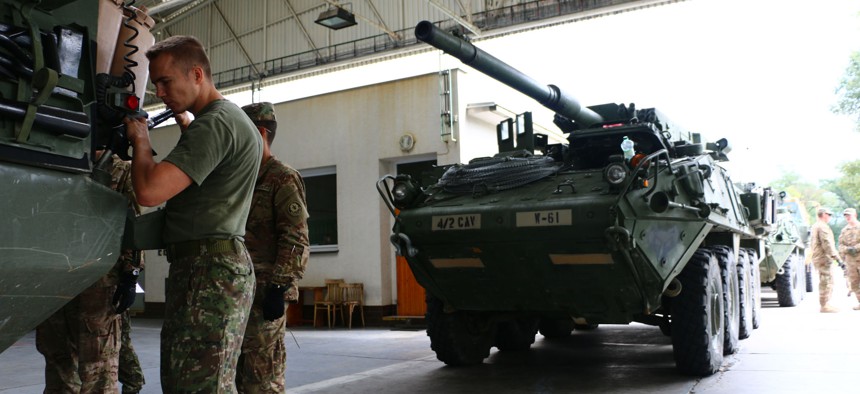
NATO allied soldiers, pictured here, refuel U.S. Stryker vehicles. The reverse proved difficult at a recent multinational exercise in Poland. U.S. Army Europe
For NATO, True Interoperability Is No Longer Optional
Here are nine ways to ensure That alliance members could fight together to defend Europe.
During a recent joint exercise in Poland, U.S. Army troops discovered that their fuel nozzles didn’t fit Polish armored vehicles’ fuel tanks. The solution was simple and inexpensive: the Americans quickly bought adaptor fittings. But without the exercise, both sides would likely have remained unaware their nozzles and fuel tanks were incompatible. Today, with NATO and its partners conducting more operations together, interoperability is more important than ever. And there’s good news: much can be achieved without great expense.
The need for NATO forces to be interoperable is, of course, nothing new. But during the Cold War, NATO land forces mostly operated side by side, each responsible for their own country (and in some cases, a chunk of Germany). With forces primarily conducting what one might call the military version of parallel play, there was no pressing need for them to be highly interoperable.
That changed with Afghanistan. Suddenly, NATO and its partners were fighting side by side in small units that didn’t have the luxury of, say, using eight different radios. Certainly, it proved impossible to settle on one single kind of radio, and commanders had to issue orders using several different types. Still, in Afghanistan, NATO made great strides in interoperability.
But Afghanistan was a war of choice. We now have to consider the possibility of a war of necessity – one in Europe. And today our forces are far smaller than during the Cold War, and they do far more together to compensate, often in units consisting of a small number of soldiers from each participating country. NATO’s Enhanced Forward Presence in Latvia, for example, draws together some 1,100 troops from six countries, including 450 from Canada, 160 from Italy, and 18 from Albania. We can no longer allow ourselves the luxury of using equipment that doesn’t work together.
But two trends may be pulling the transatlantic partners in different directions. In Europe, 23 EU member states have agreed to join together in PESCO, the Permanent Structured Cooperation. Through PESCO they plan to, among other things, focus on combining capabilities either through small clusters of countries or through instruments like the European Defense Fund. That means focus on local interoperability, not the transatlantic kind. And in the United States, the so-called Third Offset seeks to launch a new revolution in military affairs through the use of artificial intelligence, autonomous fighting vehicles, and better man-machine interfaces. This effort could leave Europe behind.
In 2001, when European allies offered to help the United States fight the Taliban, they often didn’t have the right equipment or the right operational techniques. A repeat of that situation could devastate the Alliance. Now we urgently need to address transatlantic interoperability shortfalls.
Fortunately, achieving interoperability is not primarily a money issue; it’s an issue of coordination and political will. Here are several steps that will get us a long way towards trueinteroperability – and thus stronger collective European security.
1. We should use military exercises to identify interoperability gaps and implement fixes, just as the U.S. Army Europe did during the exercise with Polish forces. In addition, NATO should see how such non-standard equipment can be kept out of the procurement streams of allies to start with.
2. Defense ministers should participate in a dedicated table-top interoperability exercise. This would allow them to see the benefits of interoperability and the consequences of failure.
3. NATO and the EU should conduct a fully coordinated crisis management exercise involving their member states’ ambassadors to the North Atlantic Council and the Political and Security Committee, respectively. This would highlight numerous interoperability issues and focus efforts on concerted solutions.
4. NATO needs to enforce its standards. For example, in NATO evaluations of allied forces, interoperability compliance should be put at the top of the grading sheet.
5. Members’ levels of interoperability compliance should be graded in a stoplight chart. NATO leaders can then use the chart to persuade red-marked member states – or, put bluntly, the worst interoperability offenders — to implement NATO standards.
6. We need to strengthen the NATO Standardization Organization — and rename it the NATO Standardization and Interoperability Organization.
7. We should embed the lessons learned during the past 15 years of out-of-area operations, especially in Afghanistan.
8. Countries that are members of both NATO and the EU should push for the EU to adopt NATO interoperability standards. We don’t need two sets of standards.
9. NATO is considering building an innovation Center of Excellence in California. The European Defense Agency should be invited to join.
NEXT STORY: The Lessons of 'American War'



